‘The Saga of Atlas & Axis’: Review and Interview with Pau its Artist
The Saga of Atlas & Axis is a very special collection of comic books that chronicles the adventures of these two anthropomorphic dogs, Atlas (Afghan hound) and Axis (Terrier mutt). Friends and neighbours in a settlement in the early middle ages, they’re forced to undertake a new life of adventures when a tribe of violent canines from the north devastate their village and enslave the few survivors, all in their absence. They travel to rescue those alive, they meet other characters in their path, and beyond their initial mission, they devote themselves to finding new discoveries in their notably animal-anthropomorphic universe.
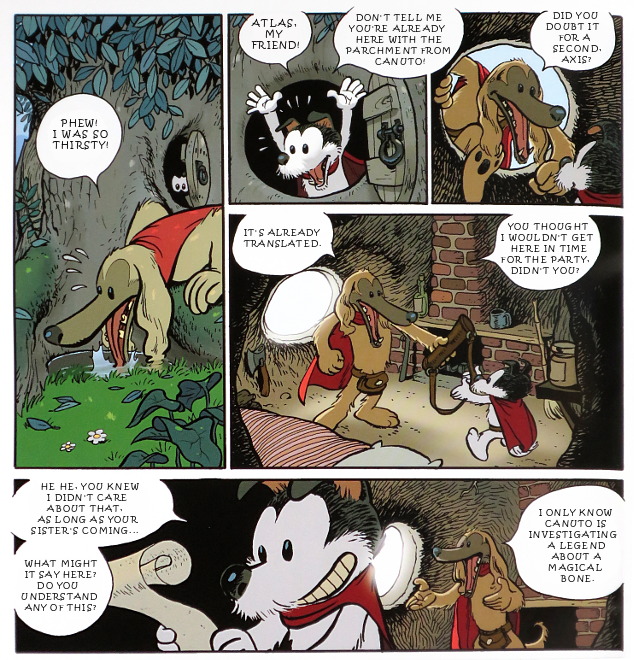
The saga as conceived by Pau, its artist and scriptwriter, consists of four volumes with a story with continuity. Created almost simultaneously in Spanish and French, the publishing of the fourth volume will be in the coming months, which concludes its story (at least for the moment).
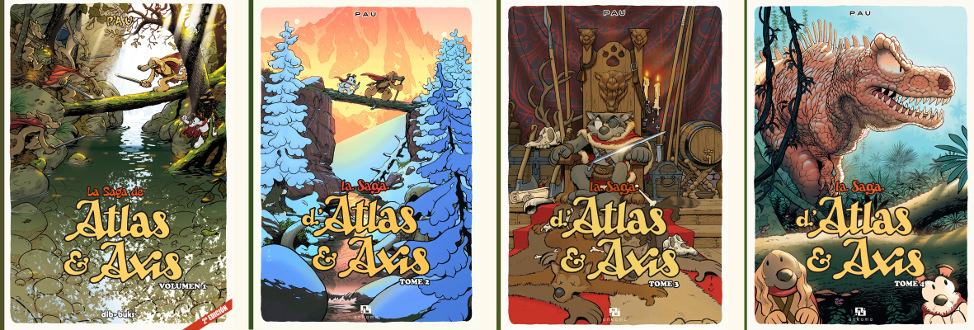
Its style is very furry. This means that it makes use of an animal anthropomorphism which, some say, is the most common in the fandom, the closest to trends within the fandom or in current media. The characters are humanoid animals (mostly dogs) who, while they have a similar cognition to our own, and they’re bipedal and use clothing and tools, they also have particular traits and habits specific to their own species. They mark their territory by peeing, they follow trails with their sense of smell, and they easily fall for a lady dog, to then fall in love with a different one after a short while.
This gives the comic and its characters an adorable charm, which contrasts with the harshness of violent scenes, not especially bloody but clearly explicit. The world of Atlas and Axis is one where neither well-being nor survival is assured (rather the reverse), but every little achievement is a reason for joy and celebration. Although they don’t always make the best decisions, whatever the situation, the two doggies try to keep going as best as they can.
The Saga of Atlas & Axis reminds of other European comics, such as the adventures of Astérix and Obélix. Nevertheless, the comic from the canine duo is full of small funny gags that give it its own identity, and give context to its universe. Such is the case, for example, with the poor sheep, who for some reason sometimes explode.
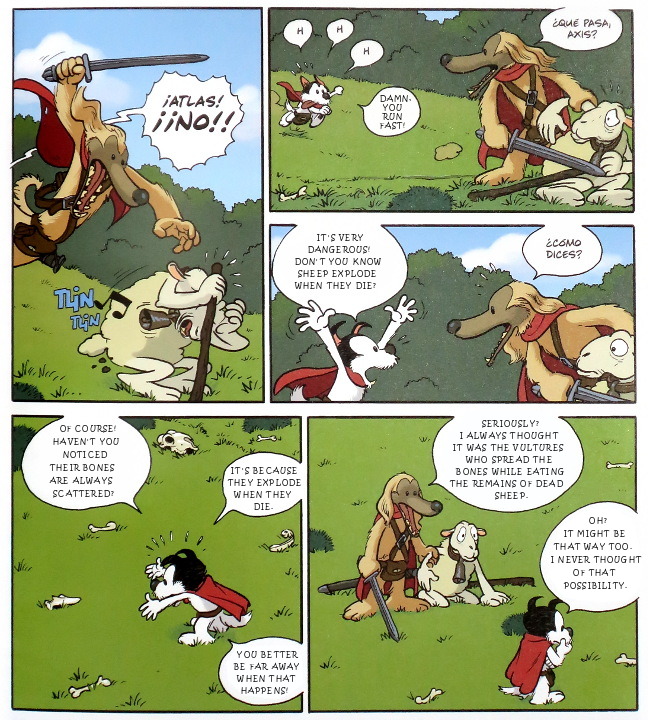
Pau, its author, is a Spanish illustrator native from Majorca. Active since the mid 90s, besides publishing his own comics, he’s published cartoons in newspapers and magazines, including the Belgian magazine Spirou. Also stands out for furry his collaboration with the French publishing house Delcourt (2006), illustrating the fable of ‘Les Deux Chèvres’ (‘The Two Goats’) in a compilation of fables by Jean de la Fontaine, whom we spoke about in our previous report on fables.
GM: Hello Pau! The Saga of Atlas & Axis is a very personal comic, isn’t it so? It has been a passion project for many years. You are the sole author of the script and the drawings. Were you inspired by personal events? Why did you want to tell this story?
P: That’s right. Initially it was my bet for becoming a professional comic author. I wanted to make a comic with international success, and I studied what makes good comics good. For many years I’ve been doing newspaper jokes on current affairs and politics. Most “adult” themes can also be told to children in a subliminal way, disguised within stories. I think they’re more effective. On one hand I wanted to show my point of view on significant topics, some a bit philosophical… and on the other, I made use of my personal experiences of course. My experiences with my dogs, my excursions and trips, which is where we learn, and reflect on, the most.
GM: A subject that’s always present throughout the comic is violence. This clashes, as it happens in other instances with animal-anthropomorphic material, with a universe where things are pretty, cute, ‘everything’s so adorable’… then bam! An arm’s cut off! It reminds me of Game of Thrones in a way (without the court intrigue). Where does this animosity stem from? 
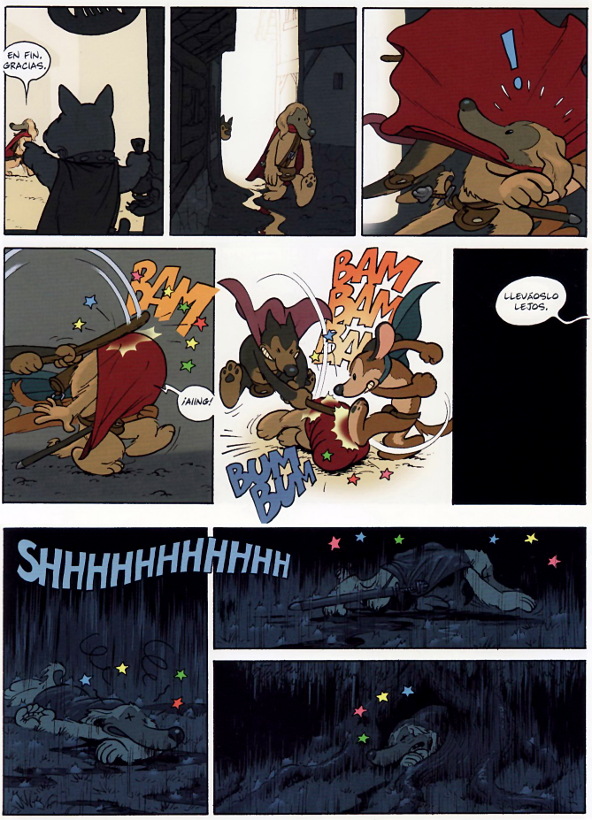
P: Yup. We currently slightly trivialize violence, because we see it so much on television. With “cute” animals violence is really violent, it’s more impactful. Violence exists in the animal world, I try to address it like they do in animal documentaries, as something inevitable, not cruel but normal. In documentaries, lions eat gazelles, and they’re for all audiences. And I also like stories to thrill, I think excitement is one of the strengths of The Saga of Atlas & Axis.
GM: In this more civilized world (though every different society in the comic thinks they’re the most ‘civilized’, and something similar may happen to us), it makes us question our belief that being alive is a right; in the universe of the comic it is a privilege. So was the case not long ago among humans some centuries ago, and such may be the case in other countries (in those where they’re at war, for sure). But, this fits well with the rest of animal behaviour of the characters.
P: Well, we’re still animals. And war is not something that happens in other countries and not our own. Look at Ukraine for example, a country in our vicinity, just about to enter the EU, and without realizing it they’ve started a war. Our stability is very fragile, as History shows. Sometimes we believe we’re superior to animals, or different from them; in the Saga the ridiculousness of that attitude is exposed. They too believe themselves to be superior to other animals…
GM: Why, specifically, did you choose animal characters, or anthropomorphic animals, instead of people?
P: Mainly for three reasons. One, because I think it’s easier for the reader to identify themselves with the characters, since we’ve all been pups and many we’ve had doggies. Another one, because through animals I can better show emotions and attitudes that we consider human. All emotions are shown in a stronger manner, I aim to the most primitive side of the reader’s heart. And another reason, is because I enjoy drawing animals more 
GM: The inking is flawless. The color contrast is highly distinguishable. The shading is subtle or non-existent, typical ‘cartoon shading’, which gives it a distinctly comic look. There are really beautiful vignettes, especially when there are water reflections or landscape panoramas. Is it digital art? Was it drawn by hand? How did you draw it?
P: Thank you! The color is digital, the drawing and inking were done on paper. I don’t like being in front of a screen for long, burning my eyes, but digital color lets you rectify easily and prints almost exactly like you choose to, unlike color on paper, which often changes too much. The drawing and the inking I can do on paper, in a traditional way. I uploaded some videos on YouTube on the process of creating the comic pages, the videos can be seen at my channel “Pau cartoonist” (link⇒).
GM: Aaah, I see there you’re using Adobe Photoshop, is that your digital tool of choice? And a tablet, of course.
P: Well, it’s the only one I know how to use a bit! 
GM: It says in your blog that the fourth volume of The Saga of Atlas & Axis is already published (in French). How do you usually write, in French first? In both languages and you publish the French one first? Do they translate it for you?
P: After several years it’s mixed in my head, sometimes Axis surprises me saying something in French that doesn’t fit so well in Spanish, other times they use expressions in Spanish that can’t be translated… a funny thing I wanted to do throughout the Saga was using animal phrases and idioms, such as “putting one’s head in the wolf’s mouth” or “it’s raining cats and dogs”, and it turns out many of them exist in several languages. Unfortunately, some are lost in translation, but luckily, I’ve had very good translators for the different languages, who follow the spirit of the work and sometimes find phrases in their language, related to animals, that are super fun and don’t exist in Spanish. Yes, the fourth volume was published in French in September, and in Spain we’re waiting for the comic book convention of Barcelona (March 2017).
GM: The fact that it’s published first in French, does it have anything to do with the French / Belgians reading more comics?
P: Yes. And also, the French / Belgian publishers usually pay authors sufficient royalties in advance to allow them to draw the comics.
GM: About the translation into English, is it definitely going to be published?
P: The publishing company Titan Comics bought the rights, and will be publishing it in May of 2017, in the US and UK.
GM: When you started the comic, did you intend to finish the saga at some specific moment? Is the fourth volume the last volume? Might there be more?
P: I had an ending thought out, but I could have delayed it indefinitely. The publisher preferred that I keep it to four volumes, so I used that ending. It concludes the story well. But, you know, Star Wars were only 3 movies and look at what happened later…
GM: Oooh so it ends there… I was going to suggest that you put a Golden Retriever in the story, but okay…
P: Hehe, many friends asked me to include their dogs  Atlas and Axis themselves are based on real dogs, one mine and the other from a friend.
Atlas and Axis themselves are based on real dogs, one mine and the other from a friend.
GM: What comics would you say had the most influence on you? Which comics do you like the most?
P: I could make a very long list of comics and authors I like that influenced me greatly, and I’d still leave many unnamed. But I like to mention them, because I might uncover them to some readers. I value them when they’re well drawn, and that they tell interesting or amusing stories, well-told stories: Tezuka, Corben, Moebius, Segar, Will Eisner, Disney, Toriyama, Munuera, Uderzo, Goscinny, Rosinski, Van Hamme, Bryan Talbot, Otomo, Sakai, Mordillo, Quino, Blain… Max… Jan…
GM: Ah you name big ones. And others I don’t know.
P: Franquin, Hermann, McCay… They’re also great, I recommend them! 
GM: You’ve also published other comics, and you’ve worked with the publishers of Spirou. Is there any other project you’d like to highlight?
P: I made short stories for Spirou, and two small comics, many of them with animals. As far as more ambitious projects go, I have some with animals like Atlas & Axis, but set in different times. I plan to make a whole collection. (Shows the image)
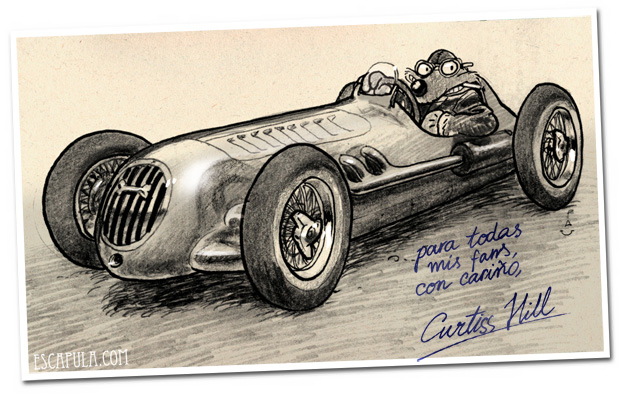
GM: Oh how cute! What animal is Curtiss Hill?
P: He’s a dog. He’s the famous pilot doggie* 
*(translator’s note: ‘And another pilot doggie!’ is a common shout at fairs where stuffed animals are used as a prize.)
GM: Besides what we’ve talked about so far, would you like to add something?
P: I could say that I’m probably the only one who instead of walking his dogs, my dogs walk me, because Atlas & Axis have taken me to comic conventions and fairs from different cities in Europe. And I’ve learned to bark in different languages thanks to their foreign editions. Seems true that animal language has no frontiers!
GM: Oh how cuuute 
GM: Thank you very much for answering my questions, Pau. And a hug!
P: You’re welcome, thank you for your interest in the Saga! Likewise!
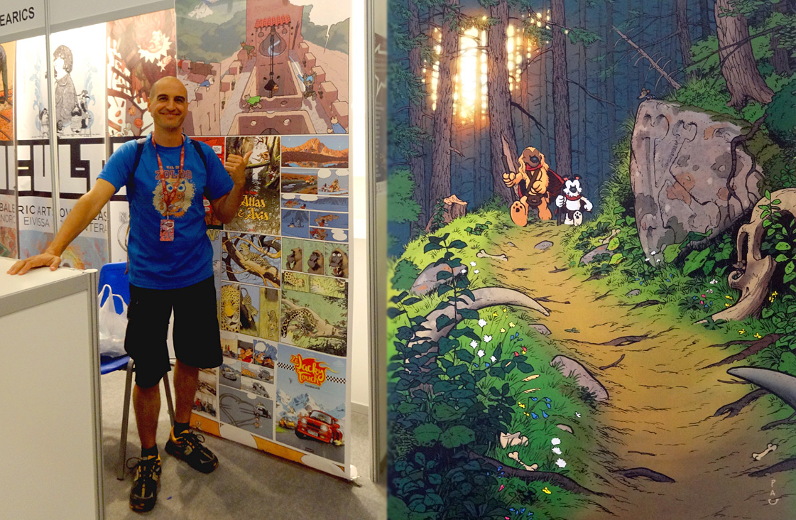
‘The Saga of Atlas & Axis’ is available for sale in Spanish through Dibbuks (link⇒), volumes with approx. 80 pages in color, at 16 € per volume. They’re also available for sale in French through the publishing company Ankama (link⇒). Pau has his own blog at Blogspot (link⇒), where you can follow his ventures.


Comments / Comentarios